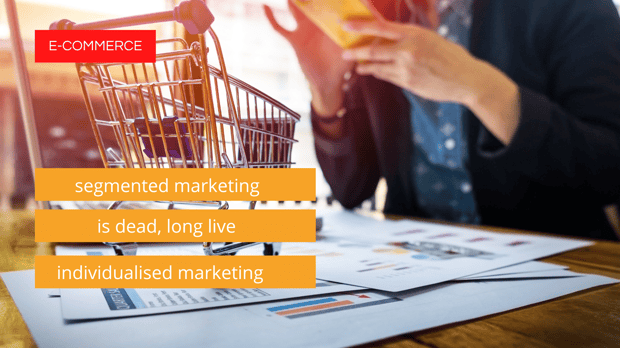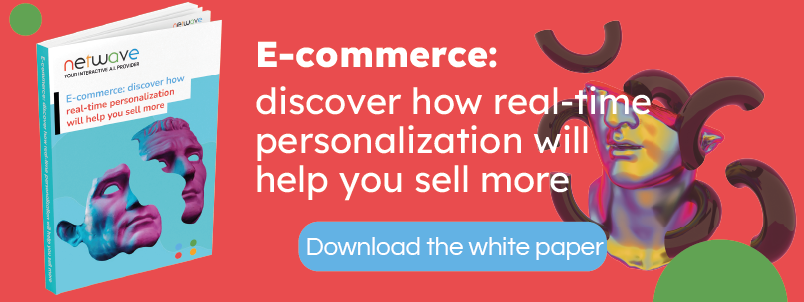
Marketing is applied at different stages of the buying cycle: acquisition, conversion, loyalty... And each stage has its own objective. In the acquisition phase, the challenge is to generate traffic on your e-commerce site. In the conversion phase, the aim is to transform the site visitor into a customer.
While segmented marketing can be effective for acquisition, it quickly shows its limits regarding conversion and loyalty. Individualised marketing is, therefore, much more relevant. Here are some explanations.
Acquisition: an essential marketing segmentation
One of the marketing techniques used to generate traffic on an e-commerce site consists of sending campaigns to its targets. However, in this acquisition phase, the targeted people have yet to visit the e-commerce site: you do not know them individually. You have yet to have the opportunity to collect data about them. You depend essentially on the profiles created by 3rd party partners. You rely on the profiles created by the 3rd party partners and are obliged to assume their needs and expectations based on these profiles.
To do this, you have no choice but to rely on statistical bases to define typical customer profiles. For product P, the statistical study will reveal, for example, that the main target is women aged 40-50 who are interested in decoration and turn to top-of-the-range products. In the acquisition phase, the e-commerce site can then push an advertising campaign presenting product P to people in the "woman, 40-50 years old, decoration, upmarket" segment.
Let's take an example: Mrs Martin is a Facebook user. She has entered her date of birth on her profile. She is 45 years old. She is subscribed to several decoration pages and interacts more specifically with publications that present high-end products. Based on this data, Facebook can affiliate Mrs Martin with the segment mentioned above, which the e-commerce site can address with a Facebook Ads campaign.
Given its poor knowledge of Mrs Martin, the e-commerce site needs help implementing individualised marketing at this stage of the purchasing cycle. However, segmented marketing allows it to address people presumed to be interested because they belong to the target segment.
Conversion: the limits of the statistical approach
You will have understood that segmented marketing remains (for the moment) the most effective approach in the acquisition phase. In the conversion phase, the target's visit to the e-commerce site changes the situation. The site can now discover the case in real-time thanks to the visitor's browsing data: it is no longer obliged to assume it. Segmented marketing and its statistical approach, thus, reveal weaknesses in terms of granularity and relevance.
The statistical approach to segmented marketing is also to attach the visitor to a predetermined segment to recommend products that have worked best with other individuals in that segment. However, this practice does not consider the unique situation of each visitor at any given time. Once exposed to the e-commerce site's offer, Mrs Martin may, for example, move away from decoration products to furniture products. The statistical approach will not be able to take this evolution into account: the products highlighted will always be the decoration products most purchased by the members of the segment to which she has been affiliated, even though these products do not interest her at this specific moment. The segmented approach becomes limiting here or even counter-productive because the site can refine its understanding of the visitor through the data it collects in real time. Individualised marketing then becomes possible and much more relevant!
Individualised marketing: for real-time navigation personalisation
If the e-commerce site can discover the visitor's needs in real-time, it can deploy an individualised marketing approach.
Why? Firstly, because it can collect much richer data on the visitor. It can therefore escape the more or less coarse segmentation of the statistical approach. Secondly, there are now several technologies, including inductive artificial intelligence, which allow the advice given to the visitor to be instantaneous.
Inductive AI offers real-time data processing capability, allowing for decision-making to be tailored to the immediate situation on a case-by-case basis. Unlike traditional machine learning methods that apply the same model to an entire segment, inductive AI systems do not require the initial establishment of rules and the generation of predefined models.
The induction technique consists of identifying the visitor's current situation by analysing the context in which they are at a given moment and then searching for similar situations in the system's recent history to find insights applicable to the current situation. This approach suggests the best-performing content or products in similar situations to the people most similar to that specific visitor. No template is applied: the processing is done in real time with an average processing speed of 35 milliseconds. Thus, in real-time, the suggestions offered are individualised and adapted to the visitor's context, behaviour, and psychology.
The objective here is not to obtain statistical reliability but to improve commercial efficiency in recommending content or products relevant to the visitor in his current situation. Being able to suggest in 35 ms the products most purchased at the moment by visitors in similar situations is always more effective than using models that are as obsolete as they are defined! This is how the shop assistant works: he induces based on similar situations he has already encountered.
Individualised marketing based on inductive artificial intelligence technologies makes it possible to respond to all situations with great relevance.
- Did the visitor's interests or behaviour change during the visit? Your site immediately adapts to the new situation rather than continuing to push products predefined by the model that is no longer useful.
- The visitor is interested in something other than the products you recommend, leaves the page, and then returns. The inductive AI will have integrated this lack of interest into its calculation and guide the selection corresponding to this new situation rather than pushing back the products already seen and not clicked.
- The visitor leaves the site, having abandoned something in the basket. Well, inductive technology allows you to bring an individualised response immediately by sending the most relevant follow-up email to that visitor.
- He leaves the site without adding anything to the basket. You can trigger an interaction to bring him back to the site, thanks to the knowledge of the behaviour of the most recent visitors, the most similar to this visitor in this situation.
- Has he bought something? Rather than waiting a month and putting the visitor in a segment with other buyers of that product, you can trigger a real-time, individualised action, for example, by sending an email showing the most purchased complementary products by the most recent buyers most like them.
To conclude...
In a physical shop, a sales assistant can assess the customer's real-time needs and expectations through strong and weak signals. They do not try to link customers to a segment to presume their desire, need, or expectation. Why is this? Because it can do so in real-time. And today, e-commerce sites have this same capacity!
So why be less relevant when you can meet the real need of your e-commerce visitors in real time?
Netwave's inductive AI technology differs from machine learning tools for segmented marketing in that it allows real-time dynamic identification of a visitor's situation. Unlike statistical models, Netwave's inductive AI re-evaluates the situation with each new piece of data received. It allows product recommendations that are adapted to the visitor's state of mind, dynamically and in real-time, throughout their navigation.
In short, Netwave's technology discovers the visitor's real needs at each interaction, allowing it to recommend the products most purchased at that moment by the most similar visitors, thus increasing the relevance of the recommendations and maximising your chances of conversion.
The result? Up to +392% better performance than a machine learning system.
Need to see it to believe it? Schedule your personalised demo today!


